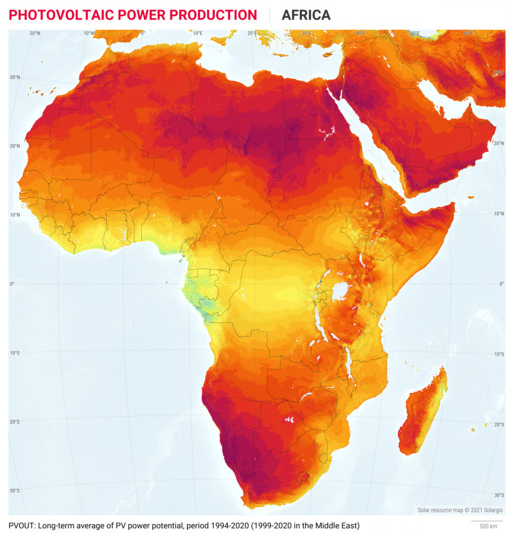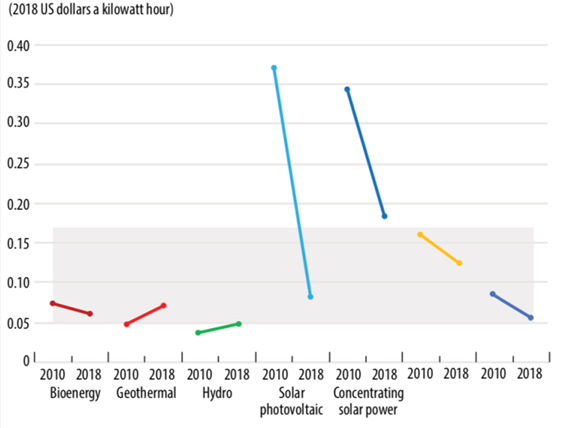1. Africa with 40% of the world’s solar energy potential
Africa is often called “hot Africa”. The entire continent runs through the equator. Excluding long-term rain forest climate areas (the Guinea forests in West Africa and most of the Congo Basin), its deserts and savannah areas are the largest on earth. In the cloud area, there are many sunny days and the sunshine time is very long.
Among them, the Eastern Sahara region in northeastern Africa is famous for its world sunshine record. The region has experienced the largest average annual duration of sunshine, with approximately 4,300 hours of sunshine per year, equivalent to 97% of the total sunshine duration. In addition, the region also has the highest annual average of solar radiation (the maximum value recorded exceeds 220 kcal/cm²).
Low latitudes are another advantage for the development of solar energy on the African continent: most of them are located in tropical regions, where the intensity and intensity of sunlight are very high. In the north, south, and east of Africa, there are a lot of arid and semi-arid areas with plenty of sunshine, and about two-fifths of the continent is desert, so sunny weather almost always exists.
The combination of these geographical and climatic factors is the reason why Africa has huge solar energy potential. Such a long period of light allows this continent without large-scale grid infrastructure to be able to use electricity.
When leaders and climate negotiators met at COP26 in early November this year, the issue of renewable energy in Africa became one of the important topics. Indeed, as mentioned above, Africa is rich in solar energy resources. More than 85% of the continent has received 2,000 kWh/(㎡year). The theoretical solar energy reserve is estimated to be 60 million TWh/year, accounting for the world’s total Nearly 40%, but the region’s photovoltaic power generation accounts for only 1% of the world’s total.
Therefore, in order not to waste Africa’s solar energy resources in this way, it is very important to attract external investment. Currently, billions of private and public funds are ready to invest in solar and other renewable energy projects in Africa. African governments should try their best to eliminate some obstacles, which can be summarized as electricity prices, policies and currencies.
2. Obstacles to the development of photovoltaics in Africa
①High price
African companies bear the world’s highest electricity costs. Since the Paris Agreement was signed six years ago, the African continent is the only region where the share of renewable energy in the energy mix has stagnated. According to the International Energy Agency (IEA), the share of hydropower, solar and wind power in the continent’s electricity generation is still less than 20%. As a result, this has made Africa more dependent on fossil energy sources such as coal, natural gas and diesel to meet its rapidly growing electricity demand. However, the price of these fuels has recently doubled or even tripled, causing energy distress in Africa.
In order to reverse this unstable development trend, Africa’s goal should be to triple its annual investment in low-carbon energy to a level of at least US$60 billion per year. A large part of these investments will be used to fund large-scale utility-scale solar projects. But it is also important to invest in faster deployment of solar power generation and storage for the private sector. African governments should learn from the experiences and lessons of South Africa and Egypt to make it easier for companies to invest in solar energy production according to their own needs.
②Policy hindrance
Unfortunately, with the exception of Kenya, Nigeria, Egypt, South Africa, etc., energy users in most African countries are legally prohibited from purchasing solar energy from the private suppliers in the above cases. For most African countries, the only option for solar investment with private contractors is to sign a lease or lease own contract. However, as we know, this kind of contract in which the user pays for the equipment is not the best strategy compared with the most commonly used contract in the world where the customer pays for the power supply.
In addition, the second policy regulatory obstacle that hinders solar investment in Africa is the lack of net metering. With the exception of South Africa, Egypt and several other countries, it is impossible for African energy users to monetize surplus electricity. In most parts of the world, energy users can produce electricity based on net metering contracts signed with local power distribution companies. This means that during periods when the power generation capacity of the captive power plant exceeds demand, such as during maintenance or holidays, energy users can “sell” the excess power to the local power company. The absence of net metering means that energy users need to pay for all unused solar power, which greatly reduces the attractiveness of solar investment.
The third obstacle to solar investment is government subsidies for diesel prices. Although this phenomenon is less than before, it still affects overseas solar energy investment. For example, the cost of diesel in Egypt and Nigeria is US$0.5-0.6 per liter, which is about half of the price in the United States and China, and less than one-third of the price in Europe. Therefore, only by eliminating fossil fuel subsidies can the government ensure that solar projects are fully competitive. This is actually the country’s economic problem. Reducing poverty and disadvantaged groups in the population may have a greater effect.
③Currency issues
Finally, currency is also a major issue. Especially when African countries need to attract billions of dollars of foreign investment, the currency issue cannot be ignored. Foreign investors and off takers are generally unwilling to take currency risk (unwilling to use local currency). In some currency markets such as Nigeria, Mozambique, and Zimbabwe, access to US dollars will be highly restricted. In fact, this implicitly prohibits overseas investment. Therefore, a liquid currency market and a stable and transparent foreign exchange policy are essential for countries that want to attract solar investors.
3. The future of renewable energy in Africa
According to a study by the International Monetary Fund, the population of Africa is expected to increase from 1 billion in 2018 to more than 2 billion in 2050. On the other hand, electricity demand will also increase by 3% every year. But at present, the main sources of energy in Africa-coal, oil and traditional biomass (wood, charcoal and dry manure), will seriously harm the environment and health.
However, with the advancement of renewable energy technology, the geographical situation of the African continent itself, especially the decline in costs, all provide huge opportunities for the development of renewable energy in Africa in the future.
The figure below illustrates the changing costs of various forms of renewable energy. The most significant change is the sharp drop in solar photovoltaic energy costs, which fell by 77% from 2010 to 2018. Lagging behind solar energy’s affordability improvements are onshore and offshore wind power, which have experienced a significant but not so dramatic drop in cost.
However, despite the increasing cost competitiveness of wind and solar energy, the application of renewable energy in Africa still lags behind most of the rest of the world: in 2018, solar and wind energy together accounted for 3% of Africa’s electricity generation, while the rest of the world Is 7%.
It can be seen that although there is a lot of room for development of renewable energy in Africa, including photovoltaics, due to high electricity prices, policy obstructions, currency problems and other reasons, investment difficulties have been caused, and its development has been at a low level stage.
In the future, not only solar energy, but in other renewable energy development processes, if these problems are not resolved, Africa will always be in a vicious circle of “only using expensive fossil energy and falling into poverty”.
Post time: Nov-24-2021


